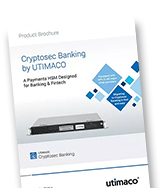- Overview
- Atalla AT1000 Payment HSM
- Cryptosec Payment HSM
- Payment HSM as a Service
- Technology Integrations
- Resources
About Payment HSMs
With millions of payment operations occurring every second, safeguarding financial assets, sensitive customer data, and organizational reputations is critical.
Payment HSMs provide the ideal cryptographic support for the secure handling of financial transactions.
Specifically designed to securely generate and store cryptographic keys used to protect financial data and transactions, they provide the highest level of security in retail, banking and financial services.
Utimaco’s Payment HSMs meet all requirements of the payment industry’s security landscape, ensuring robust protection in the ever-evolving landscape of financial transactions.
Payment HSMs: Also Available as a Service
Learn MoreResources

The Atalla AT1000 Payment HSM secures the payment ecosystem and plays a crucial role in securing inter-banking communication, user- and card authentication, as well as user data protection for both in-person and remote payments transactions.
Atalla AT1000 Payment HSM
The Atalla AT1000 Payment HSM secures the payment ecosystem and plays a crucial role in securing inter-banking communication, user- and card authentication, as well as user data protection for both in-person and remote payments transactions.
DownloadReady to Secure Your Digital Future?
Contact SalesYour download request(s):

Your download request(s):

About Utimaco's Downloads
Visit our Downloads section and select from resources such as brochures, data sheets, white papers and much more. You can view and save almost all of them directly (by clicking the download button).
For some documents, your e-mail address needs to be verified. The button contains an e-mail icon.

A click on such a button opens an online form which we kindly ask you to fill and submit. You can collect several downloads of this type and receive the links via e-mail by simply submitting one form for all of them. Your current collection is empty.







